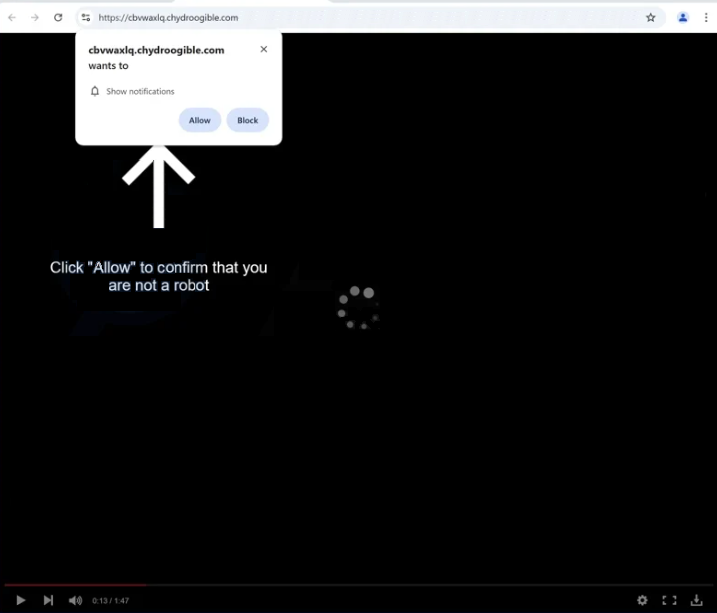Remove chydroogible.com pop-up ads
chydroogible.com is a deceptive website whose sole purpose is to trick users into allowing ads on the desktop. When you get redirected to the site, you will immediately get a browser alert saying “chydroogible.com wants to show notifications”. The site is abusing a legitimate browser feature that allows sites to show notifications on users’ desktops. Thus, if you click “Allow”, chydroogible.com will be authorized to show notifications on your desktop. Unfortunately, chydroogible.com’s notifications will be ads. Fortunately, it’s not difficult to revoke a site’s permission to show notifications.
Like all sites trying to take advantage of this “show notifications” feature, chydroogible.com has nothing on it besides a fake video player that stops playing after 10 seconds. Once the video stops playing, a browser alert will pop up saying you need to click “Allow” to confirm you’re not a robot. This is referring to the browser alert that says “chydroogible.com wants to show notifications”. By clicking “Allow”, you will enable the site to display desktop advertisements, which can be quite misleading. These ads often imitate legitimate system notifications to trick users into engaging with them. One common type of ad from sites like chydroogible.com is a fake virus alert that closely resembles a real notification from an anti-virus program. Engaging with these deceptive alerts can lead to untrustworthy websites that promote unreliable, potentially dangerous software or potentially hide malware.
If you’ve accidentally allowed chydroogible.com to show notifications, you can easily revoke this permission through your browser’s settings. Instructions can be found at the end of this report. Additionally, since these redirects may be a sign of adware on your system, we recommend performing a scan using the WiperSoft anti-virus program. Installing an adblocker program is also a good idea.
Why are you redirected to sites like chydroogible.com?
When browsing ad-heavy websites without an adblocker, it’s not out of the ordinary to get randomly redirected regardless of what you click on. Such sites often spam users with advertisements to generate revenue, and those with adult or pirated content are especially notorious for doing this. An effective adblocker program can help block both intrusive ads and unwanted redirects no matter what sites you browse.
If you notice an increase in ads and redirects—especially on sites that you’ve previously had no issues—this could be a sign of adware on your system. Adware and browser hijackers typically infect devices through a method known as software bundling. The way it works is unwanted programs come bundled with popular free programs as extra offers. These offers are technically optional, but users must manually deselect them to avoid installation. However, since these offers are hidden in settings users rarely use, many users simply do not notice the offers and are unable to deselect them. Consequently, programs using this method may be flagged as potential threats by anti-virus software.
To avoid unwanted junk on your computer, it’s important to select the right settings when installing free programs. During the installation process, you can choose between Default and Advanced settings. Default settings, which are recommended by the installation window, automatically install all bundled offers without your explicit consent. Advanced settings, on the other hand, will show each offer, allowing you to uncheck any that you do not wish to install. It’s recommended to uncheck all offers, no matter how useful they may seem at first, to keep your computer uncluttered and free from junk.
How to remove chydroogible.com notifications
Unexpected redirects might indicate a possible adware infection, so it’s recommended to scan your computer using the WiperSoft anti-virus software. Additionally, install an adblocker program if you don’t already have it as it will reduce the number of ads and redirects when browsing ad-heavy sites.
If you’ve permitted a questionable website to send you notifications, you can revoke that permission through your browser settings. If you’re not certain how to do this, you can follow the instructions provided below. Alternatively, if you prefer to avoid notification requests altogether, you can turn this feature off completely.
- For Mozilla Firefox: Open Menu (the three bars top-right corner) -> Options -> Privacy & Security. Scroll down to Permissions, press Settings next to Notifications, and remove chydroogible.com and any other questionable websites. You can permanently turn off these notification requests by checking the “Block new requests asking to allow notifications” box in the same Notifications settings.
- For Google Chrome: Open Menu (the three dots top-right corner) -> Settings -> Privacy and security -> Site Settings. Click on Notifications under Permissions, and remove chydroogible.com and any other questionable websites. You can stop these notification requests permanently by toggling off “Sites can ask to send notifications”.
- For Microsoft Edge: Open Menu (the three dots top-right corner) -> Settings -> Cookies and site permissions -> Notifications. Review which sites have permission and remove chydroogible.com and any other questionable websites. You can permanently turn off these notification requests by toggling off “Ask before sending”.
Site Disclaimer
WiperSoft.com is not sponsored, affiliated, linked to or owned by malware developers or distributors that are referred to in this article. The article does NOT endorse or promote malicious programs. The intention behind it is to present useful information that will help users to detect and eliminate malware from their computer by using WiperSoft and/or the manual removal guide.
The article should only be used for educational purposes. If you follow the instructions provided in the article, you agree to be bound by this disclaimer. We do not guarantee that the article will aid you in completely removing the malware from your PC. Malicious programs are constantly developing, which is why it is not always easy or possible to clean the computer by using only the manual removal guide.

